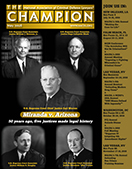May 2016

How effective are the Miranda warnings in protecting Miranda rights? (Cover Photographs: Earl Warren & William Douglas | Harris & Ewing Photography; Abe Fortas | Supreme Court Collection; Hugo Black & William Brennan | Library of Congress)
Articles in this Issue
-
Affiliate News
Affiliate News for May 2016 Champion.
-
Book Review: Dorm Room Dealers: Drugs and the Privileges of Race and Class
When considering the phrase “drug dealer,” what image pops into mind? A person of color peddling product on the street corners of an impoverished community? Or a Caucasian college student from an affluent background selling pot, party drugs, and pills from campus housing? Rafik Mohamed and Erik Fritsvold challenge those who accept as accurate only the former, stereotypical image of a drug dealer as often appears in popular media. They do so by showing that the latter version of a drug dealer is just as much a reality in the United States as the stereotype. Dorm Room Dealers is the result of a six-year study in which the authors used trust-building actions, fly-on-the-wall observations, and extensive interviews with 50 individual drug dealers — all of whom were college students in Southern California, all of whom were from middle- or upper-class backgrounds, and most of whom were Caucasian.
-
False Confessions in The 21st Century
Miranda has done little to reduce the risk of wrongful conviction resulting from false confessions. To successfully mount a false confession defense, attorneys must fashion persuasive answers to two questions: Why did the client falsely confess? How do we know it is a false confession?
-
From the President: Miranda v. Arizona — Calculating Its Net Effect
While the Miranda decision is an important part of our legal structure that in many instances serves to enforce the mandate of the Fifth Amendment, it has not been effective in greatly diminishing the number of involuntary confessions.
-
Informal Opinion: The Role of NACDL And Its Affiliates in Ensuring the Continued Vitality of Miranda
Over the past 30 years, NACDL and California Attorneys for Criminal Justice (CACJ) helped shed light on the implications of police training on interrogation practices that were intended to circumvent Miranda to permit police to either initiate or continue questioning. Police training and interrogation practices received additional attention in 2004 when the U.S. Supreme Court decided Missouri v. Seibert.
-
Miranda at 50
Criminal defense counsel should be vigilant in enforcing the constitutional rights embodied in the Miranda decision.
-
Miranda Redux: The Impact of Dickerson v. United States
The enactment of 18 U.S.C. § 3501 was an attempt to replace the strict dictates of Miranda with the congressional version of a “totality of the circumstances” test. In Dickerson v. United States, however, the Supreme Court made it clear that the Miranda advisement is constitutionally based and thus not subject to modification by statute.
-
Miranda Warnings and Waivers: Often Heard But Seldom Understood
How effective are the Miranda warnings in protecting Miranda rights? Do arrestees understand the words and sentences? Richard Rogers and Eric Drogin discuss core misconceptions potentially compromising intelligent Miranda waivers.
-
Miranda’s Legacy
To the extent interrogation practices have improved and police officers follow proper procedures, Miranda has had continuing value. Subsequent decisions, nevertheless, limited its application. Paul Ulrich explains how some of the issues have been resolved.
-
NACDL News: Clemency Project 2014 Applauds Commutation of 61 Federal Prison Sentences
In his first clemency grants since December 2015, President Barack Obama commuted the sentences of 61 prisoners on March 30, 2016, 25 of whom were applicants whose petitions were supported by Clemency Project 2014.
-
NACDL News: NACDL Press to Publish Book by Defense Attorney Andrea D. Lyon
On March 28, 2016, NACDL announced that its publishing unit, NACDL Press, will publish a groundbreaking work on women in criminal defense by leading criminal defense attorney, legal scholar, Dean and Professor of Law at Valparaiso University School of Law, and decades-long NACDL member Andrea D. Lyon. The book is expected to be released in 2017 and will be titled “The Feminine Sixth: Women for the Defense.” In this work, Ms. Lyon will tell the stories of women lawyers who are in criminal defense — public and private — but are not necessarily on the speakers’ circuit or otherwise well known.
-
NACDL News: New Report Investigates South Carolina Courts That Convict and Jail Defendants Without a
Municipal and magistrate courts in South Carolina routinely violate the Sixth Amendment rights of individuals who are accused of low-level offenses and cannot afford an attorney, says a report by NACDL and the ACLU.
-
NACDL News: Stakeholders Meet to Discuss Alternative Sentencing
Criminal justice stakeholders met in Washington, D.C., on March 7-8, 2016, to engage in a dialogue focused on priorities for expanding the use of effective alternative sentencing programs.
-
NACDL News: U.S. Supreme Court Affirms Sixth Amendment Right to Defense Counsel of One’s Choice
In a widely awaited decision concerning the right to counsel and the government’s pretrial seizure of a defendant’s assets, the U.S. Supreme Court ruled on March 30, 2016, that a defendant has a Sixth Amendment right to use her own “innocent” property to pay a reasonable fee for the assistance of counsel. The issue arose in Luis v. United States (14-419) when a grand jury charged Sila Luis with paying kickbacks and engaging in other crimes related to health care.
-
NACDL® 2016 Election Procedures
NACDL® 2016 Election Procedures.
-
What Happened In Miranda?
Paul Ulrich explains how he and other lawyers became involved in Ernesto Miranda’s case. The intense reaction to Miranda v. Arizona, he says, failed to recognize that the decision was not a major “suspects rights” victory. Instead, the decision was a compromise that favored the government.
